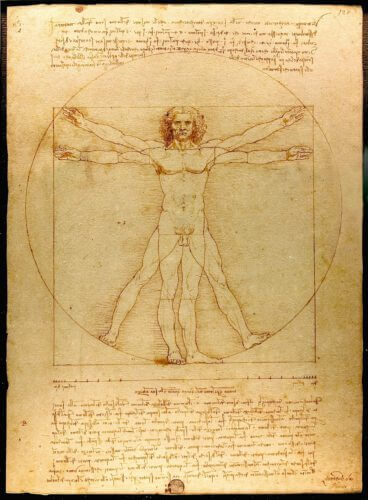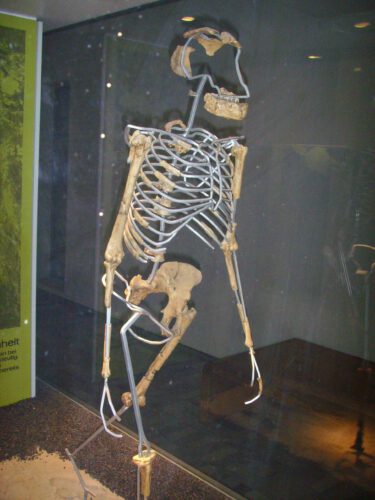An anonymous surfer wonders: why do humans have such long legs? Like, what role does their length play? It's not like we run fast or have to be terribly tall. They are just there

For some surfers, the question will seem strange, what does "long legs" mean? According to Abraham Lincoln, legs should be long enough to reach the ground and we all seem to meet this criterion. "Man is the measure of all things" Protagoras taught and the familiar relationships of the human body as described and sketched in detail by Leonardo da Vinci appear to us to be natural and perfect. In his book "Malkomia Yaffia", S. Yizhar describes how it is possible to build a complete figure based on the length relationships between the parts of the body from a footprint "Everyone knows that the length of the footprint of the foot is the length of the hand, the length of a person's face, from the chin to the hairline, and that a person's height is About seven times the length of his foot, and if you have a heel print, you already have a person of his stature, and we can also mention here the width of a man's hands, which are as high as his stature, which is seven times the length of his foot, from the tip of his foot to the top of his foot, the ancients already knew everything and also drew squares and traced circles , and calculated wonderful calculations and long ago proved how everything was already in one hand, in one foot.." (For those who were confused by the terminology, the "piece of the hand" is the part of the hand between the elbow and the wrist that is as long as the foot). But comparing the proportions between our body parts and those closest to us in the animal kingdom reveals that these relationships are not obvious and that the anonymous surfer is indeed right: our legs are unusually long. In the apes (chimpanzees, gorillas) the ratio between the length of the arms and the length of the legs is about 0.9, so that when they stand, their hands reach below the knees, and with us the length of the arms is only 0.7 - 0.6 of the length of the leg. According to Leonardo da Vinci's painting "Vitruvian Man" which represents the "perfect body proportions" the ratio is two thirds and measurements made on large populations yielded results quite similar to Leonardo's paintings - 0.68.
Measuring fossil bones shows that the arms did not shorten but the legs lengthened in evolution. But one basic premise in the question is still questionable: are we not running fast? Humans do not develop high speeds when walking on fours, but the longer the legs, the longer the strides and the easier it is to run long distances, one of the reasons for the Kenyan dominance in the long Olympic runs is the typical body structure: long legs and a thin body. As we will see later, our bodies are indeed quite well adapted to marathon running. Long distance running seems to have been very important to our ancestors when they moved from the forests to living in open spaces. A longer leg means fewer steps (and less energy) for the same distance of movement. Our relatives the dwarf chimpanzees (bonobos) sometimes stand and walk on their two hind legs, but they only do so for a short distance, in the rain forests, climbing ability and agility are important, but in tangled vegetation, it is impossible to run for long distances and their body structure is indeed not adapted for this. In 4, a skeleton of "Lucy" who lived about 1974 million years ago was found in Africa, Lucy belongs to the genus Australopithecus (Latin: Australopithecus afarensis.) which is one of the stages in the development that led to man. Lucy's brain volume is similar to that of a chimpanzee but from the structure of her knee it is clear that she walked on 3 legs. 2 million years of evolution (since Lucy's ancestors separated from the apes) allowed her to stand 2 centimeters tall, but her body structure is quite close to her ape ancestors - the arm/leg length ratio is 110. About 0.85 million years ago, a series of changes in the body structure began, of which the lengthening of the legs was one of them. If "monkey" body proportions like Lucy's are enough to allow standing upright and walking on two legs, what happened that necessitated the lengthening of the legs?
If we are to believe Dennis Bramble and Daniel Lieberman who examined the development of the skeleton and muscles during evolution, then 2 million years ago our ancestors, who until then quite resembled "Lucy", began to develop characteristics that facilitate long distance running. It means that the long-legged among Lucy's children had a higher chance of producing offspring than their squat brothers. As mentioned, the lengthening of the legs was not an isolated change, a series of anatomical adaptations made our body from head to foot suitable for running. With the lengthening of the leg, the tendons and ligaments that connect the muscles to the bones also developed so that they function as springs that optimize the utilization of muscle power for movement. The ability to move independently of the shoulders from the neck has developed so that coordinated movement of the arms and legs helps to maintain balance while running (without having to shake the head for that as well). The structure of the ankle and foot has changed to provide an increased push with each step (in the apes and in our ancestor Lucy the ankle is less flexible). Additional changes make it easier for the body to cool itself during running: we developed the ability for monkeys not to sweat from the forehead and face, veins passing through the areas of the face that have cooled from the evaporation of sweat pass near the arteries that carry blood to the head and thus cool the blood supply to the brain. Our flat faces move the center of gravity of the head back and make it easier for us to hold the head steady even when the body is moving quickly. For our ancestors who probably subsisted on gathering and hunting in the steppes of East Africa, the ability to run made it possible to exhaust prey in a long chase, add momentum to an object thrown at the animal or simply cover a larger area in search of food.

But what would we look like if our ancestors had not developed a fondness for field runs? It is possible that some people in the world carry the answer on their bodies. A rare genetic disease called UNER TAN (after the researcher who characterized it) manifests itself in limb proportions and posture typical of monkeys and a profound mental retardation that manifests itself mainly in a low ability to communicate. The researcher who examined the loks in the syndrome are all members of the Ulas family in southern Turkey, claims that this is autism, meaning a "return to the evolutionary roots". The ratio of the length between the arm and the leg in the patients is 0.9 - 0.8, which means the proportions are quite close to our ancient mother Lucy, some of the people with the syndrome go over 4. They are able to absorb words but their vocabulary is small and they are only able to formulate and understand short sentences, they are not able to understand linking words like "with" or the connecting hook. Those who see those suffering from the disease as a reminder of our distant past (a strongly disputed position and far from consensus) find interest in the way patients use their hands to walk. While in chimpanzees and gorillas the knuckles bear the weight of the body, in those with overload syndrome the weight is placed on the wrist and the fingers bear no weight. The mechanical role imposed on the chimpanzee's fingers in walking limits other uses of them. Some researchers believe that the path from walking on all fours to walking on two took a different path for our ancestors that put less strain on the fingers and allowed them to take on more delicate roles.
Did an interesting, intriguing, strange, delusional or funny question occur to you? Send to ysorek@gmail.com
More of the topic in Hayadan:

One response
"Nice"
It's just that its scientific name should be corrected
of "Lucy", which belonged to a type (not a species)
Australopithecus
and for the species Afarensis,
Not as it says:
australopithecus africanus
which is the name of another species in the same genus,
The gender of "Lucy" is:
Australopithecus afarensis.
The first africanus fossils were discovered
Mainly in DRAF and they were called Africanus,
(from an African language),
And the fossil of "Lucy" is found in Ethiopia in an area called Afar
Therefore the name of the species afarensis...